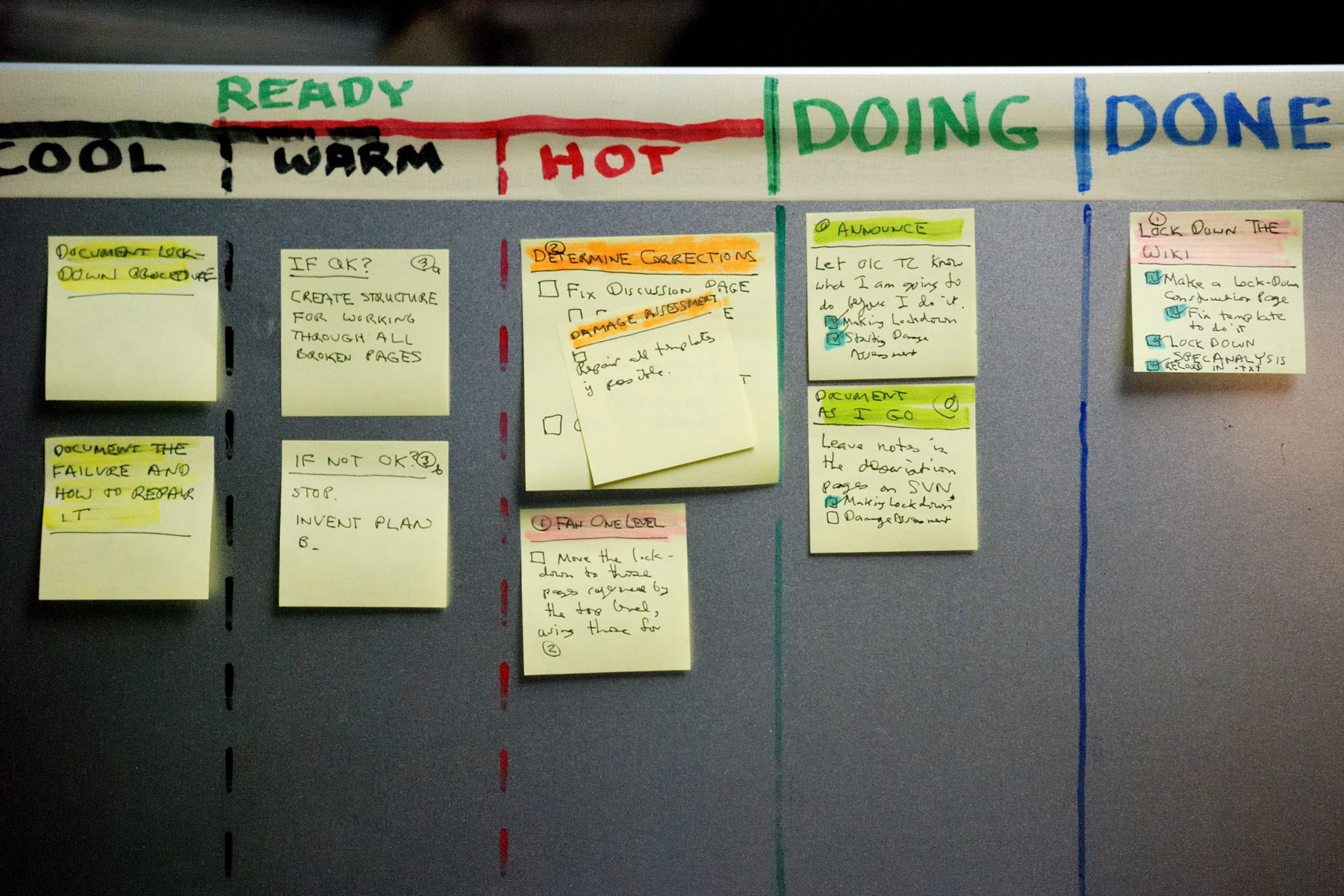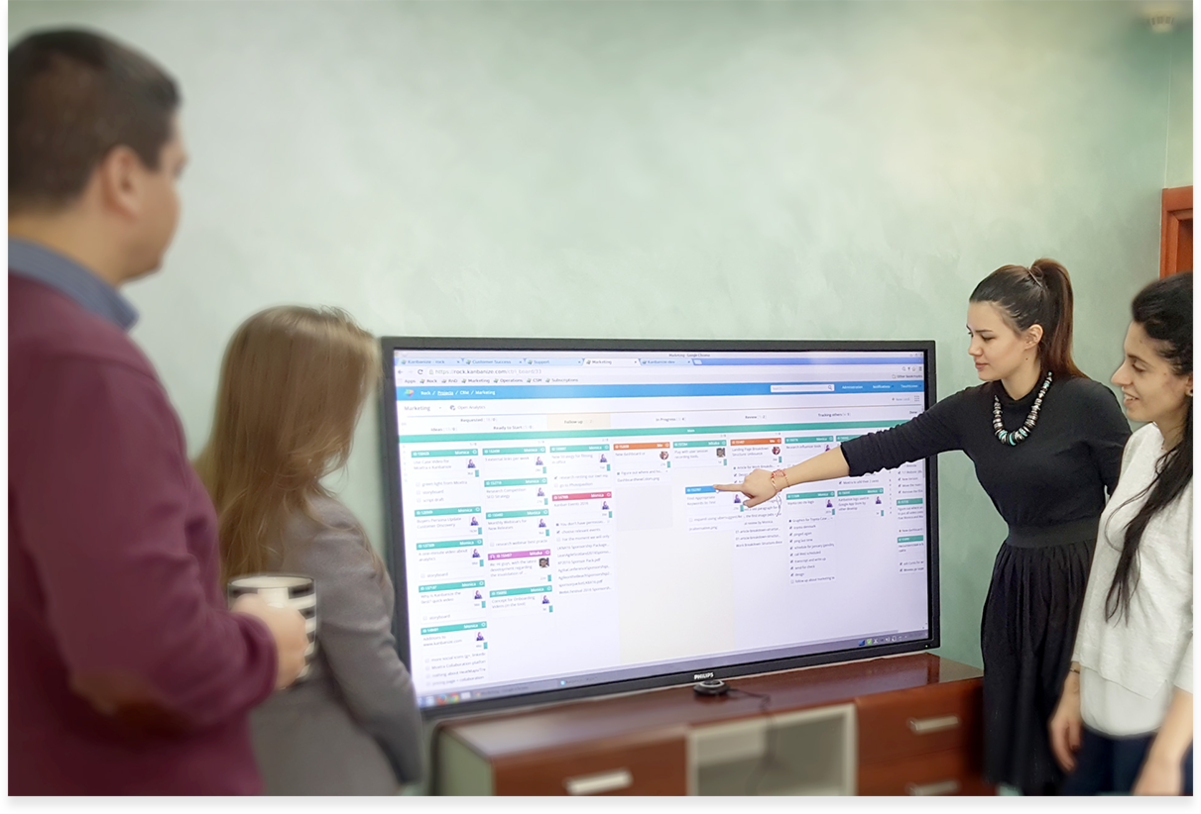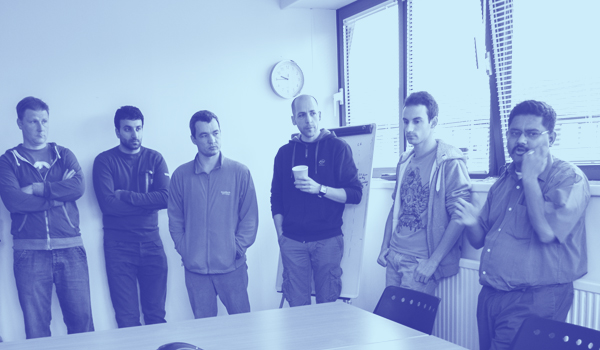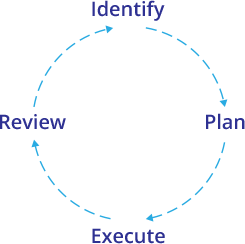Continuous improvement is a widely discussed topic, especially in the Lean and Agile communities. You can find plenty of articles that cover how continuous improvement can benefit your business; however, most of the information covers the theory with very little practical advice on how to start implementing it in your daily office life.
As a result, many leaders are having a hard time when they try to inspire their teams to pursue continuous improvement. If you are in a similar situation, these five ways to set your team up for continuous improvement will prove to be a very practical starting point in your never-ending journey.
We hope this article will help you understand how to be a continuous improvement manager/leader, not just a regular B player who gives orders.
Adopt a Kanban Board and Make it as Visible as Possible.
In order to continuously improve, you need to have the required visibility to spot weaknesses in your workflow. A very simple solution is adopting a Kanban board and making it visible to your team all the time. In other words, it is a continuous improvement board.
 Credit: Dennis Hamilton
Credit: Dennis Hamilton
Kanban boards serve as a tool for mapping your team's workflow. Their goal is to show you the stages of your workflow and how tasks are progressing through them. The simplest form of a Kanban board contains 3 basic stages: Requested, In Progress, Done. However, we advise you to do a more precise mapping and include every significant step of your workflow in order to get a concise look.
This way, the continuous improvement board will help you notice where work gets stuck. As work processes change, you are at liberty to edit your board whenever necessary in order to perfect your workflow. There are two types of Kanban boards:
- Physical boards
- Online Kanban board software
The original form of the Kanban board is physical. In order to set it up, you just need a large enough vertical flat surface (whiteboard, wall, window, etc.). To turn it into a Kanban board, you have to draw vertical lines across the surface and form columns for each step of your process that you find significant enough to visualize.
As teams consist of different roles that have their specific functions, it is a common practice to create swimlanes (horizontal deviations) on the board for each type of assignments. For example, in the software development context, you can create separate swimlanes for requested features, bugs, technical debt activities and so on.
Each assignment that your team undertakes needs to be listed as a Kanban card and start from the first column of your Kanban board (e.g. Ready to start). Each card has a single assignee and therefore it becomes really easy to see who is doing what and how their assignments are progressing at any time.
On their part, as every assignment's progress becomes visible, individual team members will likely try to show their value more than ever and aim to improve their performance continuously.
Remember that one of the primary goals of your Kanban board is to serve as an informational radiator, so make sure to put it in a place that is visible all the time to each of the team members who is working on it.
 Contemporary Kanban boards come in a digital form. Although they have plenty of advantages over their physical counterparts, visibility is not one of them.
Contemporary Kanban boards come in a digital form. Although they have plenty of advantages over their physical counterparts, visibility is not one of them.
You can easily turn your digital Kanban board into an information radiator that can spread knowledge about who is doing what at any time. You just need to find the most convenient way for you.
For example, we have placed large touchscreen TVs displaying the board of each of our teams at a central place around their quarters. In addition, we've equipped all of our conference rooms with similar screens to remove all possible prerequisites for the formation of silos in our organization. There are less expensive ways to turn your digital Kanban board into an informational radiator as well. In case you're planning a switch from physical to a digital Kanban board (and you're not using a window for a board), you can simply target a projector at the surface that you are using as a physical board to display information from your digital board.
Continuous Improvement Meetings. Simplify and Minimize.
Eliminating the activities that don't generate value for your customer is a primary task of the Lean methodology. There are 7 standard wastes of Lean that obstruct continuous improvement. Getting rid of them completely is nearly impossible, but minimizing their negative effects can help you be an efficient continuous improvement leader.
In order to generate more value for your customers, you need to carefully analyze the specific wastes of your work process and focus on removing them. When doing this, many teams don't consider the fact that meetings can easily become a waste if held too often or too seldom.
In order to control them and prevent the generation of unnecessary waste, we advise you to adopt a daily stand-up meeting in each of your teams. The stand-up meeting is an enhanced form of the typical roundup meeting that is an inevitable part of each team's activities.
It gained serious popularity in the software development industry as it is a daily ritual for teams that practice Scrum (known as Scrum meeting). Unlike your standard team meetings, the daily stand-up has a few distinguishable features that encourage teams to improve constantly. Here is why it can be called a continuous improvement meeting.

First of all, it is called a stand-up because it is held on foot. During the meeting, every member of your team must present answers to three simple questions:
- What did I accomplish yesterday?
- What will I do today?
- What obstacles are impeding my progress?
The continuous improvement meeting's agenda is to boost information sharing among your team members and therefore improve collaboration between the individuals. Stand-up can be considered successful if your team engages in discussions about how they can help each other during the day after the meeting is over.
Due to the discomfort that standing in one place for a long time creates, these meetings have little chance to go off course and be prolonged for too long. The ideal length of such a meeting is between 5 and 15 minutes depending on the size of the team.
Among the prerequisites for running a better stand-up meeting is holding it at a strange time at the beginning of the day (e.g. 9:58). Every day, you should meet at the same place and same time.
The stand-up meeting is a great way to keep everybody synchronized, but its format is unsuitable for an in-depth analysis of your team's activities. When it comes to discussing strategy, we advise you to adopt a weekly KPI meeting.
During these meetings, your team members should present data about the key performance indicators that you've agreed on. They are perfect for communicating the strategy for future activities of the team and a great place for sharing ideas on improving your process. You should monitor and compare current results to past periods of time and adapt your strategy according to the state of affairs.
Although these meetings are supposed to be longer than the daily stand-ups, you should have a clear agenda for every meeting in order to keep your team focused and take out the maximal value from the conversation.
For example, a typical KPI meeting at our company is divided into two parts. The first is all about monitoring performance indicators. We aim to keep every team member engaged so everybody is responsible for presenting data about the activities they are responsible for.
The second part of the meeting is dedicated to discussions. Every person is encouraged to share problems that bother them and propose a course of action to resolve them. During these meetings, we often hold brainstorming sessions and lay out the plans for large initiatives that we are about to start.
A good practice that can cut out the communication noise out of the meeting is to set a predefined length of the meetings according to the needs of the team. For example, our RnD team meets once a week for an hour, while the length of the marketing KPI is set for an hour and a half.
Experiment to meet the needs of your team but be careful not to waste time in discussions that are not on the agenda of the meeting and will generate more waste than value.
Being a Continuous Improvement Leader. Decentralize and Accelerate.
As we all know hierarchy plays an important role in each organization. However, if you want to be a successful continuous improvement manager, you should consider the hierarchy form a different angle.
If the authority to make decisions is centralized to an extent where individual team members don't have the liberty to take even the smallest decisions without having to consult with a direct supervisor, they will less likely try to improve an existing process.
Adopting a culture of shared leadership will allow even the frontline heroes of your team to take ownership of their assignments and seek ways to constantly improve the way they perform. Explained shortly, this leadership model encourages team members to make decisions on their own to some extent.
Not only their motivation to perform will rise but the formal leaders that hold the decision-making positions won't be bothered to solve tiny problems that are in the capabilities of your frontline team members.
This doesn't mean that you have to make radical changes to your leadership model or leave your team to act loose. You just need to place more trust in the expertise of your team members and create an environment that will encourage them to seek ways to improve and stay accountable. This can be achieved fairly easily with the help of the Kanban boards and stand-up meetings.
For example, if you need to develop a new feature for your awesome software product, you can create a Kanban card on your development team's board and list the technical requirements inside. Leave the card unassigned and let your team decide who is most suitable to work on it. Give the person the responsibility to prepare the technical design of the feature and provide her with feedback after it is done.
In the process of development, that person will be keeping you and everyone else in the team in the loop by sharing her progress during the stand-up meetings and therefore staying accountable for the successful deployment of the feature.
Optimize Communication Within Your Team.
Efficient communication is essential for the successful implementation of continuous improvement. You must find the most appropriate channels for sharing information and make sure that your team is comfortable with them and therefore sticks to them. The way your team collaborates can influence both individual and collective improvement. Therefore, the communication model of your team needs to be developed and modified if needed with the participation of everybody. There are two basic models of communication:
- Synchronous
- Asynchronous
Synchronous ways of communication are all the channels that require the immediate attention of all the participants. Typical examples of this model are face-to-face conversations, any kind of calls (telephone, Skype, Viber, etc.), video conferences and so on.
Synchronous communication is perfect for handling matters that require immediate attention because the transfer of information is instant. However, at a coworking space, it can be very distracting for the other team members that are present. This can stop their flow of thought and disturb their focus resulting in damage to their productivity.
Asynchronous communication goes in the form of sending messages that don't require immediate attention. The most widely adopted way of communicating asynchronously in the modern-day world is through email with 5 billion active email accounts sending millions of messages a day back and forth.
Asynchronous communication is great for transferring long-form information that is hard to remember at once. Such channels are perfect for sending messages that can be addressed at a convenient time for the recipient. However, if you need an immediate response, using asynchronous means for communication might put you in a bad situation.
In recent years, a growing number of companies have been adopting chat platforms that are supposed to be asynchronous but in reality, are turning into a synchronous way of communication because of the notifications that alert recipients as soon as they receive a message.

In order to improve communication, you need to optimize the use of both channels so that you can make use of all their advantages without suffering their negative effects on your productivity.
For example, we rely mostly on asynchronous ways of communication. As we have implemented our own platform (Kanbanize by Businessmap) as our digital Kanban board solution, we make use of the @ mentions in the platform heavily. This way we can leave each other messages about our assignments without constantly bothering each other.
Although the benefits of using both methods in specific contexts of communication seem obvious, the majority of people don't take them into consideration and use whatever means they find most convenient without giving much thought to how this affects their colleagues.
This impedes continuous improvement and if you want to minimize the negative effects of inefficient communication, you should consider training your team when to use synchronous and when asynchronous.
Make Continuous Improvement Part of Your Culture.
Last but not least, if you want continuous improvement culture to be more than something you've read about, you need to make sure that your team finds purpose in the process of improving.
As a leader, you should know your team well enough to understand what makes them tick and what motivates them to perform better. Afterward, you should consider how to provide some sort of stimulus that will drive each member toward continuous improvement.
The most typical way is to adopt a performance-based financial bonus. Usually, it is either individual or collective. Although financial stimuli are the simplest way to motivate your team to seek continuous improvement, they certainly won't inspire them to adopt it as a frame of mind. Not to mention that it may create competition that can result in a drop of information sharing between individuals who chase the bonus and don't want their team members to surpass them.
From our experience, what makes you a good continuous improvement manager is a personal example. Leading by example has proven to be one of the most successful management tactics and it fully applies in this case as well. How can you ask your team to continuously improve when you are not doing it yourself?

Show passion for continuous improvement and agitate your team members to follow your example. Give them an intrinsic drive to seek excellence in everything they do and help them find the soft spot between personal and process efficiency. Create an environment that tolerates mistakes and encourages experimentation.
If you want to develop further and turn each individual into an even better expert and value generator, give them the resources they need to improve. For example, you can set up a company library and allow each person to request books they consider valuable (strictly professional literature of course).
Adopting a culture of continuous improvement can benefit both you, your team and your business. Finding a suitable way to begin your never-ending quest toward it doesn't need to keep you awake at night. Why don't you start by implementing these 5 ways in order to set yourself up for all the benefits that come hand in hand with improving continuously!

Alex Novkov
Content Lead
Energetic and practical, passionate about social media, creative writing, heavy weights, and outdoor activities.




